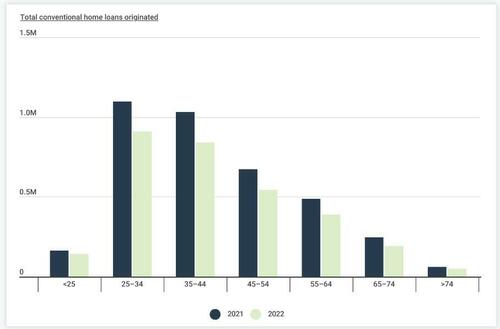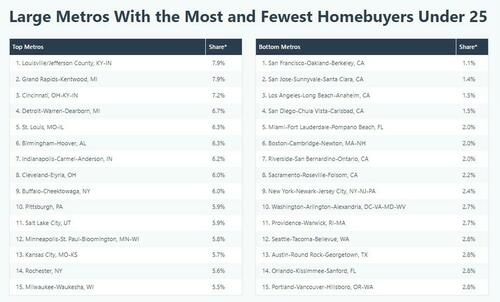
It's official: the newest generation of homebuyers are flocking to the midwest. Cities with the most homebuyers under the age of 25 are located in this more affordable part of the country, a new study released by Construction Coverage found.
The study used data from the Federal Financial Institutions Examination Council’s 2022 Home Mortgage Disclosure Act, and researchers at Construction Coverage "calculated the share of all home purchase loans taken out by applicants under 25 years old."
The study says that only "conventional home purchase loans originated in 2022 were considered for this analysis".
The key points of the study found:
- The total number of conventional home loans originated in 2022 was down across all age groups from the year prior. Among all age cohorts, 65–74 year-olds experienced the largest percentage decline, decreasing by 22.3%. Notably, the under-25 age group only experienced a 12.3% decline, the smallest of all cohorts and a sign of persistent housing demand from younger generations despite economic headwinds.
- Many of the states with the highest shares of home purchase loans from adults under age 25 are found in the more affordable Midwest, led by Iowa at 11.5%. The same trend holds at the local level, with many of the top metropolitan areas for young homeowners also found in that region.
- In contrast, high-cost coastal states including Hawaii (1.6%) and California (1.9%) have much lower shares of home purchase loans from young adults. In these areas, would-be young homebuyers face more expensive homes and higher living costs, creating a higher barrier to entry in these real estate markets.
As the study notes, millennials—those born from 1981 to 1996—now representing the largest age group in the United States and entering their prime years for acquiring their first or even second homes. These dynamics contribute to a surge of buyers vying for a diminishing pool of available properties. Freddie Mac reports that even before the pandemic hit, the housing market was facing an all-time low in supply.
While there are indications that the feverish pace of the residential real estate market may be slowing after its unprecedented surge amid the COVID-19 crisis, the path to homeownership remains steep, the study says. The competitive landscape and escalating home prices pose particular challenges for younger individuals entering the market for the first time.
The moderation in the housing market is further underscored by a decline in the issuance of conventional home loans in 2022, a trend that spanned all age brackets compared to the previous year. Among the various age groups, individuals aged 65–74 witnessed the most significant reduction, with loan originations plummeting by 22.3%. Conversely, younger buyers exhibited more resilience. Specifically, the cohort under 25 years old saw only a 12.3% drop in home loan volume, the least among all age groups. This suggests a sustained demand for housing from younger generations, even in the face of economic challenges.
The study notes that before 2022 even came into focus, there had been a rising trend in homeownership interest among younger purchasers. In 2020, the rate of homeownership for those below 25 hit 25.7%, equaling a prior high point set during the 2005 housing bubble. While this percentage experienced a minor decrease in 2021, it rebounded to 25.4% in 2022. This is notably higher than the rates documented in the 1980s and 1990s, indicating a sustained enthusiasm for homeownership among the youngest cohort of adults.
For those young adults eyeing homeownership, geographic disparities offer both opportunities and challenges. The Midwest states, spearheaded by Iowa at an 11.5% share, are notable hotspots for home purchase loans among individuals under 25. Lower housing prices in this region make it a more feasible option for younger buyers, who often have less equity compared to older home seekers. This pattern also persists at the city level, with numerous Midwestern metropolitan areas ranking high for young homeowners due to affordability.
On the flip side, coastal states with high living costs, such as Hawaii and California, boasting meager shares of 1.6% and 1.9% respectively, present significant obstacles for young potential homeowners. The steep prices and elevated cost of living in these states construct a formidable barrier to entering their real estate markets.
You can review the full study's findings and sort by metro size here.
It’s official: the newest generation of homebuyers are flocking to the midwest. Cities with the most homebuyers under the age of 25 are located in this more affordable part of the country, a new study released by Construction Coverage found.
The study used data from the Federal Financial Institutions Examination Council’s 2022 Home Mortgage Disclosure Act, and researchers at Construction Coverage “calculated the share of all home purchase loans taken out by applicants under 25 years old.”
The study says that only “conventional home purchase loans originated in 2022 were considered for this analysis”.
The key points of the study found:
- The total number of conventional home loans originated in 2022 was down across all age groups from the year prior. Among all age cohorts, 65–74 year-olds experienced the largest percentage decline, decreasing by 22.3%. Notably, the under-25 age group only experienced a 12.3% decline, the smallest of all cohorts and a sign of persistent housing demand from younger generations despite economic headwinds.
- Many of the states with the highest shares of home purchase loans from adults under age 25 are found in the more affordable Midwest, led by Iowa at 11.5%. The same trend holds at the local level, with many of the top metropolitan areas for young homeowners also found in that region.
- In contrast, high-cost coastal states including Hawaii (1.6%) and California (1.9%) have much lower shares of home purchase loans from young adults. In these areas, would-be young homebuyers face more expensive homes and higher living costs, creating a higher barrier to entry in these real estate markets.
As the study notes, millennials—those born from 1981 to 1996—now representing the largest age group in the United States and entering their prime years for acquiring their first or even second homes. These dynamics contribute to a surge of buyers vying for a diminishing pool of available properties. Freddie Mac reports that even before the pandemic hit, the housing market was facing an all-time low in supply.
While there are indications that the feverish pace of the residential real estate market may be slowing after its unprecedented surge amid the COVID-19 crisis, the path to homeownership remains steep, the study says. The competitive landscape and escalating home prices pose particular challenges for younger individuals entering the market for the first time.
The moderation in the housing market is further underscored by a decline in the issuance of conventional home loans in 2022, a trend that spanned all age brackets compared to the previous year. Among the various age groups, individuals aged 65–74 witnessed the most significant reduction, with loan originations plummeting by 22.3%. Conversely, younger buyers exhibited more resilience. Specifically, the cohort under 25 years old saw only a 12.3% drop in home loan volume, the least among all age groups. This suggests a sustained demand for housing from younger generations, even in the face of economic challenges.
The study notes that before 2022 even came into focus, there had been a rising trend in homeownership interest among younger purchasers. In 2020, the rate of homeownership for those below 25 hit 25.7%, equaling a prior high point set during the 2005 housing bubble. While this percentage experienced a minor decrease in 2021, it rebounded to 25.4% in 2022. This is notably higher than the rates documented in the 1980s and 1990s, indicating a sustained enthusiasm for homeownership among the youngest cohort of adults.
For those young adults eyeing homeownership, geographic disparities offer both opportunities and challenges. The Midwest states, spearheaded by Iowa at an 11.5% share, are notable hotspots for home purchase loans among individuals under 25. Lower housing prices in this region make it a more feasible option for younger buyers, who often have less equity compared to older home seekers. This pattern also persists at the city level, with numerous Midwestern metropolitan areas ranking high for young homeowners due to affordability.
On the flip side, coastal states with high living costs, such as Hawaii and California, boasting meager shares of 1.6% and 1.9% respectively, present significant obstacles for young potential homeowners. The steep prices and elevated cost of living in these states construct a formidable barrier to entering their real estate markets.
You can review the full study’s findings and sort by metro size here.
Loading…








